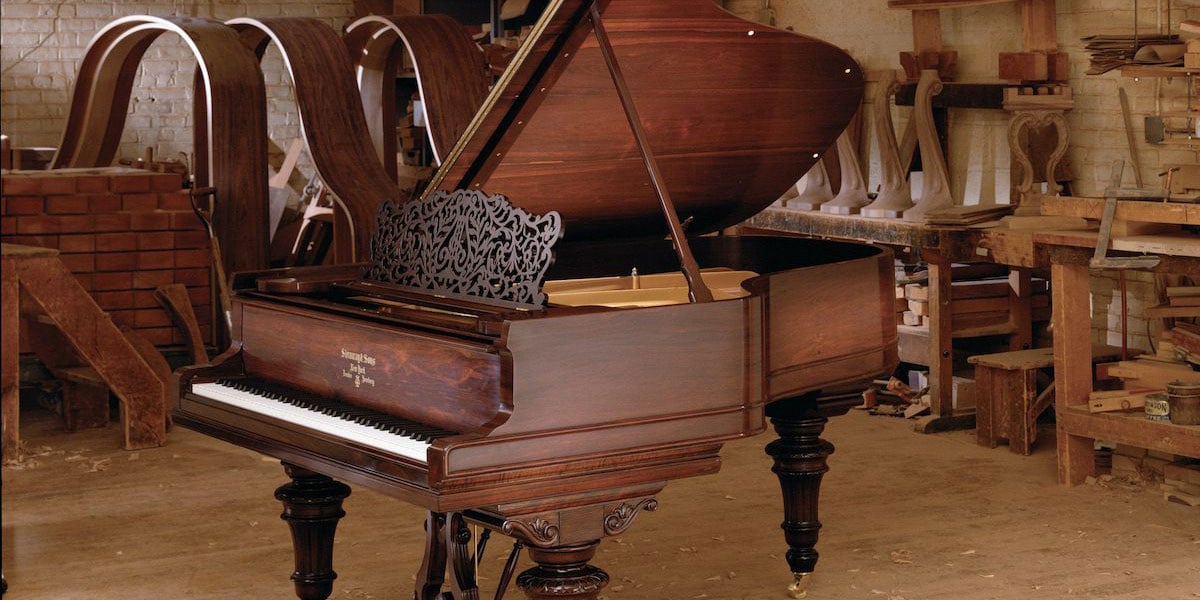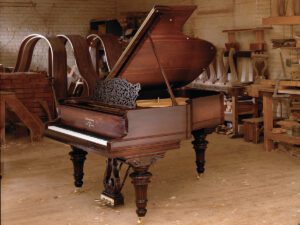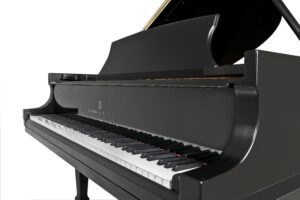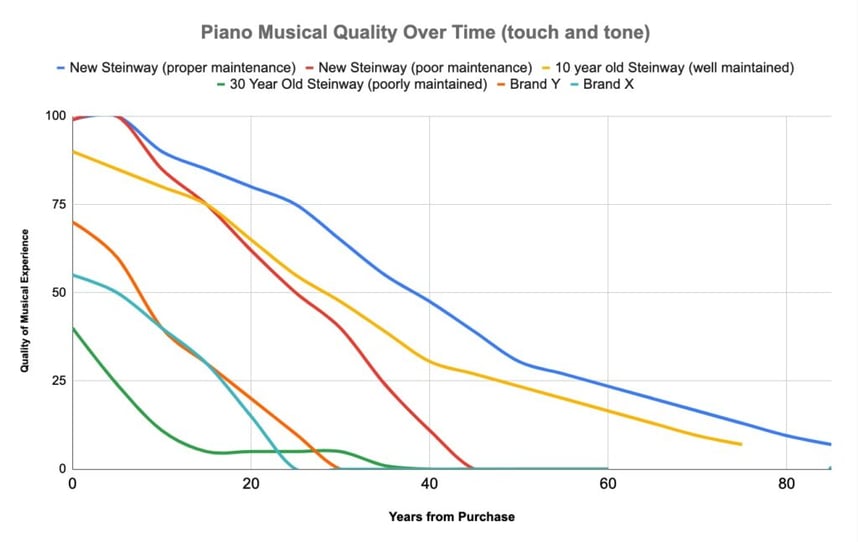How long does a grand piano last?
August 1, 2022 •Stephen Reed

With an investment as significant as a grand piano, customers understandably are curious as to how long they can expect their grand to last. As with so much in life, the answer is “It depends.” However, over the years some general conclusions can be drawn, based on the materials, assembly, and level of care given to a grand piano.

Knowing the ways to keep your piano healthy through placement in the home (e.g. away from windows), regular tuning, avoiding heat registers that can dry out the soundboard, dealing with seasonal changes, and carefully moving the grand piano when needed can all help to extend a grand piano’s life.
Even so, to avoid disappointments as your piano is passed down to your children, you need to know that the average manufactured piano lasts about 30 years, whereas a handcrafted piano like a Steinway can go well beyond 50 years.
But even just for the present generation, the buyer wants to know that their grand piano is going to be playable for years to come. Purchasing a piano is a significant investment for any home. Naturally, people want to know how long does a grand piano last?
At M. Steinert, we’ve been helping customers get answers to piano questions like this for over 160 years. We want our customers to be informed buyers so that they know what they’re getting. Understanding the different factors that play into the longevity of a grand piano will help a buyer appreciate their purchase more.
In terms of musical quality, what is a grand piano’s lifespan?
When we ask the question, “What is a grand piano’s lifespan?”, what does “lifespan” mean in a quality piano context? Obviously, if you want a grand that still has a quality musical presence, that’s different than a piano that merely is capable of making any kind of sound or one that is barely standing on its legs.
For the purposes of this article, we will discuss how long a grand piano lasts to refer to its playability and basic musicality.
Factors that affect the longevity of a functioning piano

Experience has shown that new grand pianos (without rebuilding) maintain their playability between 10 and 50 years, depending upon numerous factors expanded upon below. Note that "playable" is highly subjective between pianists.
One person's playable is another's musical disappointment. Over the years we've found that many have never experienced a high-quality piano sound and touch - and simply don't know what's possible!
Factors that can affect the musical quality of a grand piano over time include:
Initial quality/tone
- Materials: The lifespan of a grand piano is greatly affected by the quality of the woods and other materials used. As any woodworker will tell you, attention to the selection of, and the proper drying of the woods before fabricating into any shape can have a significant impact on durability. Each manufacturer maintains a recipe that meets their quality, cost and output needs. The keys used to be made from ivory and ebony in the past, but today’s piano keys are wood and plastic, which is much more durable. The higher the quality of the woods used in a grand piano, the better it can survive the natural wear and tear that comes with age.
- Craftsmanship: Most grand pianos today are mass-manufactured, to yield a lower price as compared to handcrafted models. Handcrafted grands generally can be expected to have a longer lifespan than manufactured models. Handcrafted grands generally have a lifespan at least in the 20-40 year range, sometimes over 50.
- Design: How each piano brand designs its models can affect their lifespan. For example, most piano companies’ manufactured pianos have a design that employs low-to-medium quality wood. This allows the price point to come down but with the consequence of a typically shorter musical lifespan.
Some manufacturers, like the Steinway-designed Boston, specify certain woods in critical areas (maple in the rim, and spruce in the soundboard), that have been proven to increase overall durability and tone quality.
Environment
- Temperature and humidity: Temperature and humidity fluctuate, particularly in four seasons country and coastal areas. The seasonal swings in a grand piano’s environment can damage a piano over time, limiting its lifespan. A grand piano placed near a window can exacerbate these conditions. Humidity can cause a piano’s wooden action parts to shrink and swell, also affecting its tuning.
- Air vents: In addition to external causes for temperature changes, internal temperature issues can work against a grand piano’s lifespan over time, as well. Air vents and other areas affecting the internal environment like heaters and air conditioners are to be avoided. One wants to avoid frequent changes in temperature and airflow. Direct sustained contact with devices that produce airflow can dry out a soundboard, even making it crack. That can seriously shorten a grand piano’s lifespan.
- Sunlight: Sunlight near a window over time can cause a grand piano’s elegant finish to fade. Worse, glue joints in the piano can weaken and sustained sunlight over time can cause a second way for the soundboard to dry out and crack. Direct sunlight, month by month, year by year, can contribute to a reduced lifespan for a grand piano.
General use
- Use/wear-and-tear: Obviously, the amount of play a grand piano gets can affect its ultimate lifespan. Grand pianos used by more than one person, such as those used at a college by several students, can have a level of wear-and-tear that diminishes the instrument over time.
- Aggressive playing: Aggressive playing by amateur or professional players can tax any grand piano over time. While modern grand pianos are built to take strong playing, those who abuse their pianos through harsh playing are potentially limiting their piano’s lifespan. Actions wear out, strings become compromised and weak spots in various parts/components become exposed.
Maintenance and restoration
- Loose strings: Strings can get too loose before tuning. Regular tuning can help avoid this.
- Repairs: Maintenance of one’s grand piano can include repairs as small as replacing a key or a string to more significant ones like fixing a pedal. Keeping one’s piano in shipshape is key to its long-term lifespan.
- Restoration: A full-scale restoration can add years to a piano’s life but can be very expensive. Replacing a pin block or a soundboard takes a skilled piano technician. Many who get their older grand piano restored come to realize they would have been better off with a different new piano.
Each grand piano has its own lifespan curve
Grand pianos are like people. Some may have a single health care concern, while others may have multiple issues. As a result, while each of the factors above can affect an individual grand piano’s lifespan, each one will have its own lifespan curve.
Take a look at this chart that shows piano musical quality over time for a variety of pianos:

Life cycle of a typical grand piano in the home
Again, while each grand piano has its own individual path toward establishing its ultimate lifespan, examining grand pianos over time has yielded some general conclusions about the different phases of a grand piano’s life. The following is a summary of what can happen to a piano as it ages and is published with the permission of the Piano Technicians Guild:
FIRST-YEAR
The pitch of a new piano drops considerably, as the new strings stretch and the structure settles. If the piano receives the manufacturer’s recommended three to four tunings during this time, it will stay at the correct pitch, allowing strings and structure to reach a stable equilibrium. Without these important first tunings, any later tuning will involve a large pitch raise, leaving the piano unstable.
TWO TO TEN YEARS

The pitch stabilizes, assuming regular tunings (and additional climate control devices if needed). The mechanical parts of the piano’s action wear and settle too. This causes two changes: first, the touch of the piano becomes less responsive as the parts go out of adjustment.
Secondly, the tone changes as the hammers flatten and grooves develop from repeated collisions with the strings. Periodic regulation and voicing, important parts of a complete maintenance program, correct these changes.
TEN TO THIRTY YEARS
Wear of action parts continues, the extent depending upon how hard and how often the piano is played. Normal regulation and voicing will maintain a good tone and touch if usage is moderate.
If the piano suffers wide temperature and humidity swings, it will being to show permanent deterioration during this time: loose tuning pins, rusty strings, soundboard cracks, and aging of the finish.
THIRTY TO FIFTY YEARS
After years of playing, the hammers and other action parts will be quite worn. Years of seasonal changes cause bass strings to sound dull and treble tone to lose clarity. Eventually, adjustment alone will not correct these problems, and some parts will need replacing to restore the original tone and touch.
OVER FIFTY YEARS
A few geographic areas with mild climates have older pianos still in good condition. Well-built, well-designed pianos can still be playable at this advanced age if they’ve had good care and moderate use.
However, at some point in a piano’s life, an important decision must be made:
- Should the piano be replaced? Is its life over?
- Should it be reconditioned or rebuilt (made functionally new again)?
- Should it continue to limp along with an ever-worsening tone and touch?
Eventually, it simply becomes less practical to continue maintaining an old piano. The end of a piano’s life comes when the repair cost exceeds the value of the repaired instrument.
Happily, almost any piano that has received reasonable care will have served the art of music for decades by the time its days are over.
Come in for a visit
We encourage customers to try other brands, including those that make manufactured grand pianos. Then come to our showroom in Newton to make an appointment to talk with one of our seasoned sales consultants and to play some Steinway models.
In preparation for your appointment, consider reading more about some of the popular models of Steinway grands in the following article. It will give you a closer look at 6 Steinway grand piano models so that you begin to see which ones may suit your needs best.
A review of 6 Steinway piano models: Which is the best grand for me?
Featured Articles
Categories
- Beginner Pianos (23)
- Boston Pianos (15)
- Comparisons (30)
- Designer and Specialty Pianos (8)
- Essex Pianos (10)
- Events (11)
- Featured (24)
- Institutional (3)
- Joy of Piano (15)
- Learning About Pianos (69)
- News (35)
- Pricing and Cost (19)
- Resource Center (122)
- Roland Pianos (6)
- Spirio (15)
- Steinway Pianos (70)
- Student (14)
- Teacher (13)
- Used Pianos (20)
- Videos (19)

